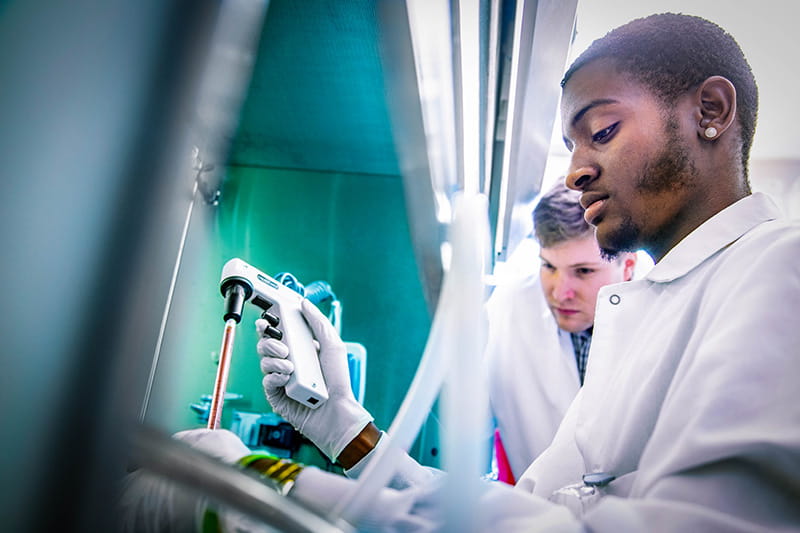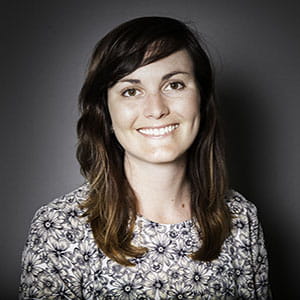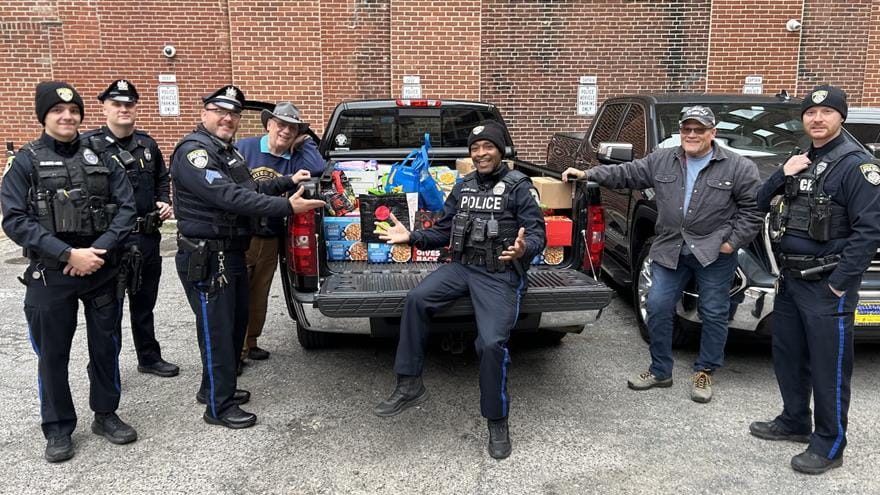A Tale of Two Colleges: Drexel and Stillman Act on Memorandum of Understanding

Justus Martin, a senior biology student from Stillman College, working with Joseph Guarnieri, a PhD/MS student in Drexel’s Department of Biochemistry & Molecular Biology in a lab located in the New College Building on Drexel's Center City Campus.
Andrea Harrison had finished up her summer-long fellowship in Drexel University’s Summer Undergraduate Research Fellowship (SURF) program, and was on her way back home to Alabama and her home institution, Stillman College, when her flight out of Philadelphia International Airport was cancelled.
A severe storm had come on quickly, forcing some planes that had already departed to turn around and causing all subsequent flights to be cancelled. Airline representatives informed Harrison that she couldn’t accept the hotel vouchers they were passing out because of her age (the minimum age requirement was 22 years old, and Harrison was only 19). She couldn’t return to her dorm on Drexel’s Center City Campus because she had already returned her keys.
She was stuck. She had to think fast. She couldn’t panic.
Maybe this wouldn’t be such an alarming situation for a seasoned traveler, but this was Harrison’s second flight. Ever. Her first was on the way to Philadelphia for the fellowship.
Maybe this wouldn’t be such an alarming situation for a seasoned traveler, but this was Harrison’s second flight. Ever. Her first was on the way to Philadelphia for the fellowship.
“It was the experience of a lifetime,” Harrison said of her fellowship overall. “It actually opened my eyes to wanting to accept more opportunities outside of Alabama — maybe even outside of the country.”
“I think that growth was something that I witnessed that's disconnected from her experience in the lab,” said Mark McCormick, PhD, provost and vice president for academic affairs at Stillman, of Harrison’s ability to calmly handle her cancelled flight. “That's just some personal growth that I think was part of the larger experience. That's just added benefit to her development as a human being.”
The Memorandum
The path to this memorandum began when Executive Vice President and Nina Henderson Provost M. Brian Blake, PhD, and Vice Provost for Assessment, Accreditation and Institutional Effectiveness Stephen L. DiPietro, PhD, expressed an interest in reaching out to historically black colleges and universities (HBCUs) — like Stillman — to take part in a consortium or roundtable at Drexel to discuss shared trends and issues. From this initial outreach, Stillman President Cynthia Warrick, PhD, asked to visit Drexel even sooner to discuss possible partnerships between the two schools.
“From that we really developed the notion of, ‘Let’s have a Memorandum of Understanding about ways that we could help Stillman, and Stillman can help us by providing experiences for our students that they might not otherwise be able to have,’” DiPietro reminisced.
In response, a Drexel task force was formed by DiPietro which included Koren A. Bedeau, PhD, vice provost for academic programs and strategic initiatives and interim vice provost for global engagement; Shivanthi Anandan, PhD, interim vice provost for undergraduate education; and Elisabeth Van Bockstale, PhD, vice provost for graduate education. This initial agreement outlined the following: Stillman would send two of their undergraduates to Drexel in the summer of 2018 to partake in the biomedical sciences division of its already established SURF program administered through the College of Medicine and by Anandan. In exchange, Drexel would send two teaching assistants to Stillman that fall to teach in its biology program.
Drexel had the research infrastructure and prestige. Stillman had the availability and need for PhD students in STEM fields to be able to teach classes on their own — a rare opportunity at Drexel. This first phase clearly met the simple criteria for the memorandum — it was a win-win all around.
“That is why it is so important to have collaborative interactions between different institutions,” said Josiah Sampson, PhD, dean of the School of Arts and Sciences at Stillman, of the benefits of the two very different universities coming together to create such opportunities. “By having these things, we broaden the perspective, we broaden the level of thinking that these individuals have, and that produces a better tomorrow all the way around.”
The Opportunities
Harrison’s experience at Drexel started off a little rocky, just like its ending. She had just finished up her freshman year as a biology major at Stillman, and though she already had the goal of one day earning both her MD and PhD degrees, she entered the lab at Drexel with little research experience, especially compared to fellow SURF program participants who were upperclassmen.
“‘I can’t mess up’ — that’s what my mindset was on,” Harrison said back in July 2018 while still in her fellowship. “But it’s OK not to know everything; it’s OK to ask questions. That’s also what I learned here. That’s what research really is about, asking questions and wanting to find the answer to that question, then asking more questions.”
“‘I can’t mess up’ — that’s what my mindset was on,” Harrison said back in July 2018 while still in her fellowship. “But it’s OK not to know everything; it’s OK to ask questions. That’s also what I learned here. That’s what research really is about, asking questions and wanting to find the answer to that question, then asking more questions.”
“I knew that the prestige that Drexel holds behind its name would be a great look on my résumé for school,” Martin said.
Martin worked with Michael Bouchard, PhD, in Drexel’s Department of Biochemistry & Molecular Biology to analyze different factors as to how the expression of the HBx protein affects the replication of the HBV virus. Though he said he had “good days and bad days” during the fellowship, the experience was eye-opening for Martin, and made him want to do more research in the future.
“It’s definitely a great opportunity, especially for students at Stillman, to get out and do research with more resources than we have at Stillman,” Martin said. “Students there definitely need to take advantage of the opportunity. I definitely think it’s a great thing.”
Fast forward to the fall 2018 term, and instead of Stillman students getting acclimated to the fast-paced nature of Philadelphia, it was time for two Drexel biology PhD students to get used to the slow-paced way of life in Tuscaloosa, Alabama, where Stillman College is based.
“I think it was a very cute city, just very slow-paced compared to what I’m used to because I've been [at Drexel] for going on nine years,” said Jasmine Alexander-Floyd, a PhD candidate in Drexel’s Biological Sciences program through the College of Arts and Sciences.
“To me it was very much like where I grew up [near the Poconos], which is not boring, necessarily, but everything is very spread out,” added Lauren Klabonski, PhD candidate also in the Biological Sciences program. “You have to have a car and it's very rural.”
“To me it was very much like where I grew up [near the Poconos], which is not boring, necessarily, but everything is very spread out,” added Lauren Klabonski, PhD candidate also in the Biological Sciences program. “You have to have a car and it's very rural.”
“This is leading me more in the teaching direction,” Alexander-Floyd said. “I'm definitely more motivated because I think we really had a positive impact on the students.”
Both Alexander-Floyd and Klabonski taught three classes over the course of the term, instructing biology underclassmen and upperclassmen as well as non-majors. And instead of working as a TA where coursework for students is usually prescribed by faculty, the two PhD candidates did everything from scratch at Stillman — wrote lectures, created assessments and assignments and ran labs.
“It's difficult to find a way to teach your own class, and I really wanted to find something that wasn't just regurgitating something someone else had made,” Klabonski said of her interest in the Stillman opportunity. “I feel like the freedom is one thing that I really wanted. And also, I knew that it was going to be different from the environment [at Drexel], and I think the challenge to me was sort of like, ‘If I can do it here then I can do it anywhere.’ So it was like a personal confidence-building exercise.”
Alexander-Floyd and Klabonski also worked with the Stillman students to boost their own confidence academically. For instance, many of the Stilman students had never been exposed to the lab environment before, but welcomed the opportunity.
“That was probably the one piece of feedback that I got back from a lot of my students is how much they enjoyed taking the science that they're learning about and turning it into hands on [experience],” Alexander-Floyd said.
Klabonski said she also tried not to underestimate her students, and implored them to rise to the occasion and adapt when they were struggling versus bringing things down a level for them.
“I feel like they lacked a lot of confidence in themselves, not because they couldn't do things, but because they just didn't feel confident trying,” Klabonski said.
And they weren’t alone as they navigated their first solo teaching experiences. It helped to regularly check with each other about their individual courses and share tips on what worked and what didn’t. They also met with Sampson once a week to discuss everything from their personal research to the classroom experience to trends in education and science research as a whole.
“The experience they got, I think, is priceless going forward,” Sampson said. “If they should go into an academic environment, now they have some previous experience, some tools from which to draw on, so that they can more easily navigate that academic experience to undergraduates to come.”
All in all, Alexander-Floyd and Klabonski enjoyed the freedom that this opportunity — brought about by the MOU — afforded, but also knew that they didn’t have to go it alone.
“Be very open-minded and don't think that you're going to go from Drexel to Drexel,” Alexander-Floyd said in terms of her advice to future teaching assistants who head to Stillman. “Don't think that with really anywhere that you go, but go and submerge yourself in your surroundings and adapt and remember why you're there — that you're there one, to get experience, and also to try and change the lives of students.”
The Future
There are already plans to expand the MOU by Stillman welcoming teaching assistants in both biology and mathematics for next year’s cohort — giving even more Drexel students the experience that Alexander-Floyd and Klabonski received. It’s also a very advantageous arrangement for Stillman.
“To be able to cover courses on our side for undergraduate students is crucial,” Sampson said. “It is almost like hunting for unicorns to look for trained and able individuals in the STEM area.”
Drexel will also host two new Stillman students this summer as part of the SURF program. Future expansions may also include a longer-term opportunity for individuals from Stillman to come to Drexel, now an R1 research institution, and partake in opportunities they may not get otherwise.
“It's a good way for us to increase the diversity of our own student body and potentially increase the diversity of faculty, particularly in areas that are STEM in nature,” DiPietro said. “This is a win-win, I think, for all the participants.”
The MOU is also helping Stillman embark on an initiative to expand how the college awards academic credit for internship-based experiences — looking to Drexel’s co-op program as a model.
“We're going to be leaning on the longstanding program that Drexel has in place to look for ways that they do that and then how do we apply that in our own particular environment,” McCormick said.
All in all, the fact that two very different, but very dedicated-to-mission institutions have come together in this way is higher education at its finest, McCormick said.
“Higher education is not only about the content knowledge and the training of an individual within a specific discipline … We also shape and form individuals for productive and meaningful lives,” McCormick said. “So that means providing them not only the content of their discipline, but also experiences that broaden their perspective of the world that we live in. … I think we do that better when we work together, bringing our differences and contributing that to each other. It's just what higher education hopes to accomplish at its best.”
In This Article
Drexel News is produced by
University Marketing and Communications.

